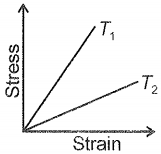Given below are two statements:
Statement I:
Almost for all metals, the modulus of elasticity decreases with a rise in temperature.
Statement II:
By increasing temperature, the intermolecular force decreases.
1.
Statement I is false but Statement II is true.
2.
Both Statement I and Statement II are true.
3.
Both Statement I and Statement II are false.
4.
Statement I is true but Statement II is false.
The Poisson's ratio of a material is \(0.4.\) If a force is applied to a wire of this material, there is a decrease in the cross-section area by \(2\)%. In such a case the percentage increase in its length will be:
1. \(3\%\)
2. \(2.5\%\)
3. \(1\%\)
4. \(0.5\%\)
For a given material, Young's modulus is 2.4 times the modulus of rigidity. Its Poisson's ratio is-
1. 0.1
2. 0.15
3. 0.2
4. 0.4
Given below are two statements:
| Statement I: | Air is more elastic than iron. |
| Statement II: | Elasticity is directly proportional to Bulk modulus and the Bulk modulus of air is more than that of steel. |
| 1. | Statement I is false but Statement II is true. |
| 2. | Both Statement I and Statement II are true. |
| 3. | Both Statement I and Statement II are false. |
| 4. | Statement I is true but Statement II is false. |
Given below are two statements:
| Assertion (A): | Hooke's law is applicable up to the elastic limit. |
| Reason (R): | Up to the elastic limit, stress is directly proportional to strain. |
| 1. | Both (A) and (R) are True and (R) is the correct explanation of (A). |
| 2. | Both (A) and (R) are True but (R) is not the correct explanation of (A). |
| 3. | (A) is True but (R) is False. |
| 4. | Both (A) and (R) are False. |
Given below are two statements:
| Statement I: | Rubber is more elastic than steel. |
| Statement II: | Deformation in steel is less than rubber for equal forces |
| 1. | Statement I is false but Statement II is true. |
| 2. | Both Statement I and Statement II are true. |
| 3. | Both Statement I and Statement II are false. |
| 4. | Statement I is true but Statement II is false. |
The ratio of Young's modulus of wire \(A\) to wire \(B\) is:

1. \(3:1\)
2. \(1:3\)
3. \(\sqrt{3}:1\)
4. \(1: \sqrt{3}\)
In which of the following cases, an elastic metal rod will not undergo elongation?
(1) The rod falls freely.
(2) It is pulled with constant acceleration on a smooth surface.
(3) It is pulled with constant velocity on a rough surface.
(4) All of these
A metallic rope of diameter \(1~ \text{mm}\) breaks at \(10 ~\text{N}\) force. If the wire of the same material has a diameter of \(2~\text{mm},\) then the breaking force is:
| 1. | \(2.5~\text{N}\) | 2. | \(5~\text{N}\) |
| 3. | \(20~\text{N}\) | 4. | \(40~\text{N}\) |
If stress versus strain plot for a metal at two different temperatures are shown below, then:

1.
2.
3.
4.






